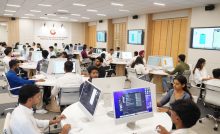The Indian economy isn’t doing as well as popular perceptions would let you believe. Nisarg Kamdar analyses the financial health of the country to find out why
From throttling ahead at surreal growth rates approaching 10% to stuttering growth rates, the Indian economy has sure come a long way. From being the pick of emerging markets for investors, the Indian economy’s fall off the global map has been accentuated by the economic gloom that encapsulates the global financial systems.
How did we end up here?
* A deadly cocktail of mismanagement of the economy, policy paralysis, inability to push through reforms, failure of the checks and balances in our systems to secure us for the proverbial rainy day and the onslaught of Eurozone crisis which triggered global economic meltdown.
* Lack of political capital with the present Prime Minister contributed to the government’s indecisiveness and procrastination which in turn led to reform measures like unwarranted subsidies, decontrol of diesel prices, addressing supply constraints and some others remaining in a permanent state of limbo.
* The rising fiscal deficit – difference between a government’s expenditure and total revenue it generates – due to falling tax receipts but enhanced expenditure arising from the government’s callous spending habits.
* The ballooning current account deficit – measurement of a country’s trade in which value of goods and services it imports exceeds value of goods and services it exports – has exposed the rupee to untold misery.
* India’s import bill is dominated by our energy demands. Unless we reduce our dependence on oil imports for our energy needs and develop infrastructure to tap non-renewable and renewable resources in India, we will be unable to cope.
The American effect
After the financial market collapse in 2008, the US Federal reserve started a programme of quantitative easing wherein they started buying bonds from its member banks. When the Fed buys from banks, the banks have more money to lend to other banks. As banks try to unload their extra reserves, they drop the interest rate. Credit is thus available at lower interest rates, spurring economic activity.
In September 2012, the Federal Reserve began pumping $40 billion per month into the economy through purchase of treasury bonds. This excess money found its way to emerging markets such as India and fuelled our recovery after the 2008 economic collapse. This inflow aided us in achieving growth rates of 9% while most western economies were either stagnating or in recession. Now as the American economy shows signs of recovery, the Federal Reserve has announced a ‘tapering’ of its quantitative easing policy. This has prompted the ‘Great Exit’ of money from emerging markets. Investors now no longer have access to cheap credit to invest in emerging markets, so they have been pulling money out of the Indian economy.
Collective failure
When the going was good policy formulators, regulators, the central bank, and the corporate industry failed to secure our gains and ensure that the fundamentals of the economy were on a strong footing. As Raghuram Rajan, the present RBI governor, incisively quipped, “strong growth tests economic institutions’ capacity to cope, and India’s were found lacking.”
Effect on the ground
* The primary effect has been spiralling expenses due to high inflation but stagnating incomes.
* The rising price, especially those of food commodities, has pinched the aam aadmi.
* Lack of reforms has led to drying up investment which has made essentials such as housing dearer.
* Financial products are no longer attractive investment options, with most Indians choosing to park their money in gold assets.
* Diesel and petrol rates have shot through the roof since we import most of our fuel requirements. Consequently, public transportation has become a much larger drain on personal resources.
* The most significant impact is the lack of jobs, especially for skilled workers. Absence of appropriate jobs for graduates has become chronic and unless the economy revives we very well might surrender the gains we have made in our efforts to stifle brain drain.
Measures by the government
* The government has decontrolled petrol and is actively considering decontrolling of diesel pricing. This means doing away with the subsidy it used to provide for fuel.
* The Cabinet Committee on Investments (CCI) has been set up as a mechanism for fast track clearances for big ticket projects. Dubiously, the government has also sought to tackle the issue of environmental clearances by changing the environment minister rather than tackling institutional lacunae.
* 51% FDI in multi-brand retail has been allowed but this has failed to attract substantial investment due to political uncertainty, since majority of the political parties are publicly opposed to this policy.
* The import duty on gold has been hiked. This helps reduce the import bill and thus decrease the current account deficit since majority of the gold purchase is imported. It also makes gold a less attractive investment option and thus encourages the public to invest savings in financial markets which can stimulate vigorous economic activity.
The road ahead
The Indian economy needs serious consideration and requires several reforms to return to growth rates near 10%. Though the government is aware of the steps required, the present political climate makes these steps highly unlikely since a majority of them are unpopular measures. In spite of having raised the limit for FDI in several sectors, investment has still dried up due to the perception that this government’s days are numbered. Investors prefer biding their time till the next general elections which will be held around April-June. This ensures a government which will offer continuity and will have the required political capital for undertaking tough measures. A miraculous recovery at this point seems highly unlikely.
Absence of appropriate jobs for graduates has become chronic and unless the economy revives we very well might surrender the gains we have made in stifling brain drain.
Volume 3 Issue 8
Recent Posts
Understanding The Importance of Branding for Businesses
“Products are made in the factory, but brands are created in the mind.” - Walter…
Why are leaders required to upskill in digital business leadership?
In today's world, technology changes industries and how we do business. Companies now need leaders…
Ways To Cope With Job Loss Or Career Setbacks
In the year 2024 itself, 619 companies laid off a total of 151,484 employees. Isn't…
Behind the Hype: Are Social Media Influencers Really Shaping Consumer Behavior?
In today's world we constantly want to look perfect especially when it comes to clothes,…
10 Most Peculiar Beauty Standards Across the Globe
We often think beauty is having a good skin, buying the right skincare products, investing…
Galgotias University students shine on the global stage: Victory at Apple’s Swift Student Challenge 2025
New Delhi, March 28th, 2025: Under the visionary leadership of Dr. Dhruv Galgotia, CEO of…



